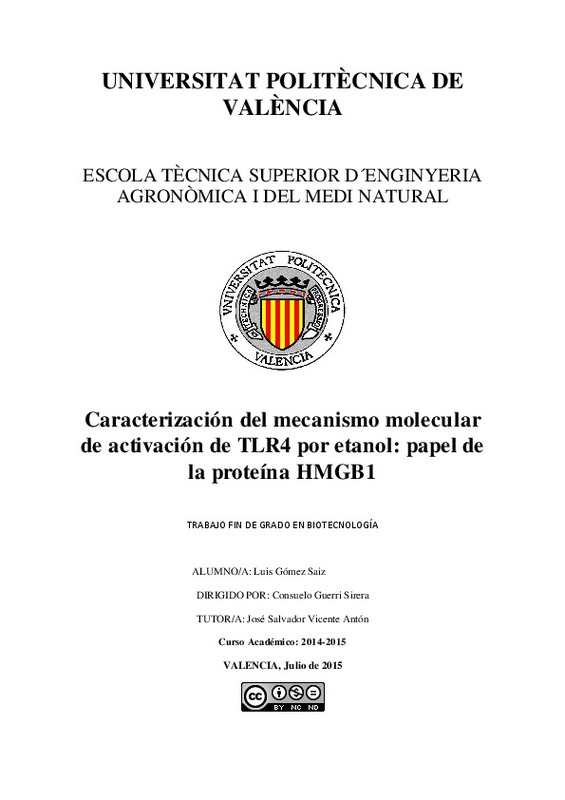JavaScript is disabled for your browser. Some features of this site may not work without it.
Buscar en RiuNet
Listar
Mi cuenta
Estadísticas
Ayuda RiuNet
Admin. UPV
Caracterización del mecanismo molecular de activación de TLR4 por etanol: papel de la proteína HMGB1
Mostrar el registro sencillo del ítem
Ficheros en el ítem
| dc.contributor.advisor | Vicente Antón, José Salvador
|
es_ES |
| dc.contributor.advisor | Guerri Sirera, Consuelo
|
es_ES |
| dc.contributor.author | Gómez Sáiz, Luis
|
es_ES |
| dc.date.accessioned | 2015-09-07T18:16:52Z | |
| dc.date.available | 2015-09-07T18:16:52Z | |
| dc.date.created | 2015-07-17 | |
| dc.date.issued | 2015-09-07 | es_ES |
| dc.identifier.uri | http://hdl.handle.net/10251/54383 | |
| dc.description.abstract | [ES] Resultados recientes del laboratorio de Patología Celular del CIPF demuestran que el etanol, a concentraciones con relevancia fisiológica de etanol (10-50 mM), es capaz de activar la señalización y respuesta del receptor del sistema innato inmunitario, TLR4, en células gliales (microglia y astroglia) desencadenado una respuesta inflamatoria en cerebro que causa neuroinflamación y daño neural. De hecho, la eliminación genética de TLR4 protege contra el daño neuroinflamatorio causado por el etanol. Datos recientes postulan que la activación del TLR4 se produciría por la HMGB1 (high-mobility group box 1), proteína que se libera por las células neurales ante un insulto de daño tisular o inflamatorio. En base a estos últimos resultados, el objetivo de este trabajo es esclarecer el mecanismo molecular de la activación del TLR4 por parte del etanol y/o la proteína HMGB1 en la respuesta neuroinflamatoria causada por el etanol. Este objetivo se abordara en cultivos primarios corticales de neuronas, astrocitos y microglía procedentes de animales silvestres y animales carentes del receptor TLR4 ( TLR4-KO) y se evaluara el mecanismo de liberación de HMGB1 en los diferentes tipos células neurales en presencia y ausencia de varias concentraciones de etanol (10, 25 y 50 mM). | es_ES |
| dc.description.abstract | [EN] Recent results from the CIPF Cellular Pathology Laboratory demonstrate that ethanol, at physiologically relevant concentrations of ethanol (10-50 mM), is able to activate the response and signaling of the innate immune system toll-like 4 (TLR4) in glial cells (microglia and astroglial cells) triggering a neuroinflammatory response that leads to neural damage. Indeed, TLR4 genetic deletion protects against neuroinflammatory damage caused by ethanol. Recent data postulate that activation of TLR4 is produced by HMGB1 (high-mobility group box 1), a protein released by neural cells due to an insult or inflammatory damage. Following this line of thinking, the aim of this study is to elucidate the molecular mechanism of activation of TLR4 by ethanol and/or HMGB1 protein in neuroinflammatory response caused by ethanol. This objective is approached by using murine primary cultures of cortical neurons and astrocytes and HMGB1 release will be evaluated in both cell types after stimulation with various concentrations of ethanol (10, 25 and 50 mM). | es_ES |
| dc.language | Español | es_ES |
| dc.publisher | Universitat Politècnica de València | es_ES |
| dc.rights | Reconocimiento - No comercial - Sin obra derivada (by-nc-nd) | es_ES |
| dc.subject | Etanol | es_ES |
| dc.subject | Neuroinflamación | es_ES |
| dc.subject | Astrocitos | es_ES |
| dc.subject | Neuronas | es_ES |
| dc.subject | Inmunidad | es_ES |
| dc.subject | Ethanol | es_ES |
| dc.subject | Neuroinflammation | es_ES |
| dc.subject | Astrocytes | es_ES |
| dc.subject | Neurons | es_ES |
| dc.subject | Immunity | es_ES |
| dc.subject.classification | PRODUCCION ANIMAL | es_ES |
| dc.subject.other | Grado en Biotecnología-Grau en Biotecnologia | es_ES |
| dc.title | Caracterización del mecanismo molecular de activación de TLR4 por etanol: papel de la proteína HMGB1 | es_ES |
| dc.type | Proyecto/Trabajo fin de carrera/grado | es_ES |
| dc.rights.accessRights | Abierto | es_ES |
| dc.contributor.affiliation | Universitat Politècnica de València. Escuela Técnica Superior de Ingeniería Agronómica y del Medio Natural - Escola Tècnica Superior d'Enginyeria Agronòmica i del Medi Natural | es_ES |
| dc.contributor.affiliation | Universitat Politècnica de València. Departamento de Ciencia Animal - Departament de Ciència Animal | es_ES |
| dc.description.bibliographicCitation | Gomez Saiz, L. (2015). Caracterización del mecanismo molecular de activación de TLR4 por etanol: papel de la proteína HMGB1. http://hdl.handle.net/10251/54383. | es_ES |
| dc.description.accrualMethod | TFGM | es_ES |
| dc.relation.pasarela | TFGM\27554 | es_ES |
Este ítem aparece en la(s) siguiente(s) colección(ones)
-
ETSIAMN - Trabajos académicos [3541]
Escuela Técnica Superior de Ingeniería Agronómica y del Medio Natural






